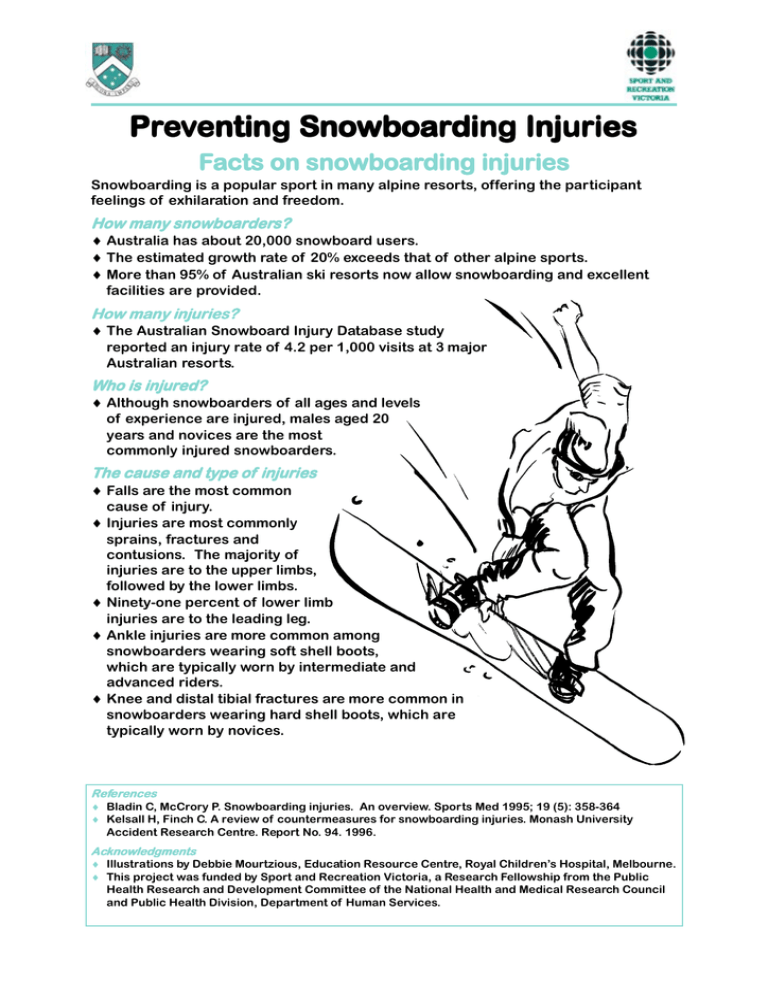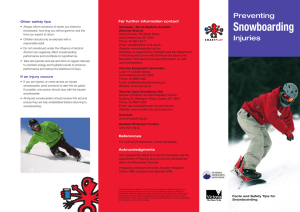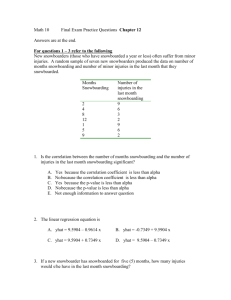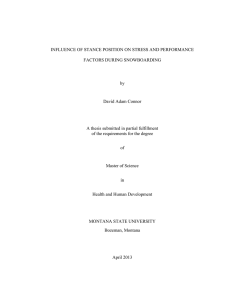Pr Preeeeevvvvventing Snowboar enting Snowboar enting Snowboarding Injuries
advertisement

Pr eventing Snowboar ding Injuries Pre Snowboarding Facts on snowboar ding injuries snowboarding Snowboarding is a popular sport in many alpine resorts, offering the participant feelings of exhilaration and freedom. How many snowboar der s? snowboarder ders? ♦ Australia has about 20,000 snowboard users. ♦ The estimated growth rate of 20% exceeds that of other alpine sports. ♦ More than 95% of Australian ski resorts now allow snowboarding and excellent facilities are provided. How many injuries? ♦ The Australian Snowboard Injury Database study reported an injury rate of 4.2 per 1,000 visits at 3 major Australian resorts. Who is injur ed? injured? ♦ Although snowboarders of all ages and levels of experience are injured, males aged 20 years and novices are the most commonly injured snowboarders. The cause and type of injuries ♦ Falls are the most common cause of injury. ♦ Injuries are most commonly sprains, fractures and contusions. The majority of injuries are to the upper limbs, followed by the lower limbs. ♦ Ninety-one percent of lower limb injuries are to the leading leg. ♦ Ankle injuries are more common among snowboarders wearing soft shell boots, which are typically worn by intermediate and advanced riders. ♦ Knee and distal tibial fractures are more common in snowboarders wearing hard shell boots, which are typically worn by novices. Ref er ences efer erences ♦ Bladin C, McCrory P. Snowboarding injuries. An overview. Sports Med 1995; 19 (5): 358-364 ♦ Kelsall H, Finch C. A review of countermeasures for snowboarding injuries. Monash University Accident Research Centre. Report No. 94. 1996. Ac knowledgments Acknowledgments ♦ Illustrations by Debbie Mourtzious, Education Resource Centre, Royal Childrens Hospital, Melbourne. ♦ This project was funded by Sport and Recreation Victoria, a Research Fellowship from the Public Health Research and Development Committee of the National Health and Medical Research Council and Public Health Division, Department of Human Services. Pr eventing Snowboar ding Injuries Pre Snowboarding Saf ety tips ffor or snowboar ding Safety snowboarding Good pr epar ation is impor tant pre para important ♦ Undertake pre-season conditioning and training. ♦ Prospective snowboarders should undertake lessons to learn correct riding and falling techniques. ♦ Establish what the snow conditions are like, dont ride in poor conditions. Equipment: suita bility and maintenance suitability ♦ Choose carefully equipment to suit your skill level and size. ♦ Soft shell boots, for novices are recommended. ♦ Keep equipment in good working order. ♦ Ensure all rental equipment is properly fitted and adjusted ♦ Wear clothing, including gloves, that is waterproof and breaths and head coverings to prevent excessive heat loss. Incr ease saf ety with sound tec hniques and pr actice Increase safety techniques practice ♦ Be aware of, and adhere to, general snow conduct and safety codes. ♦ Only snowboard on slopes suitable to your level of ability. ♦ Stay on main trails and groomed runs. ♦ Be cautious if boarding in deep powder among trees. Never do this alone. ♦ Young or beginner riders should be well supervised. Other saf ety tips safety ♦ Snowboards should be attached to the rider by a leash to prevent injuries to others on the slopes. If an injury occur s occurs ♦ Ensure all injured snowboarders receive adequate treatment and rehabilitation before resuming snowboarding. For fur ther inf orma tion contact: further informa ormation ♦ Snow Sports Victoria, Mailbag 6, 120 Collins Street, Melbourne 3000. Ph: (03) 9650 7270 ♦ Accident Research Centre, Monash University, Building 70, Wellington Road, Clayton, Vic. 3168 Ph: (03) 9905 1808 ♦ Dr. C. Bladin, Australian Snowboard Injury Data Base Study, 62 Erin Street, Richmond, 3121. Fax: (03) 9427 7929. Email: 100355.1702@compuserve.com.



